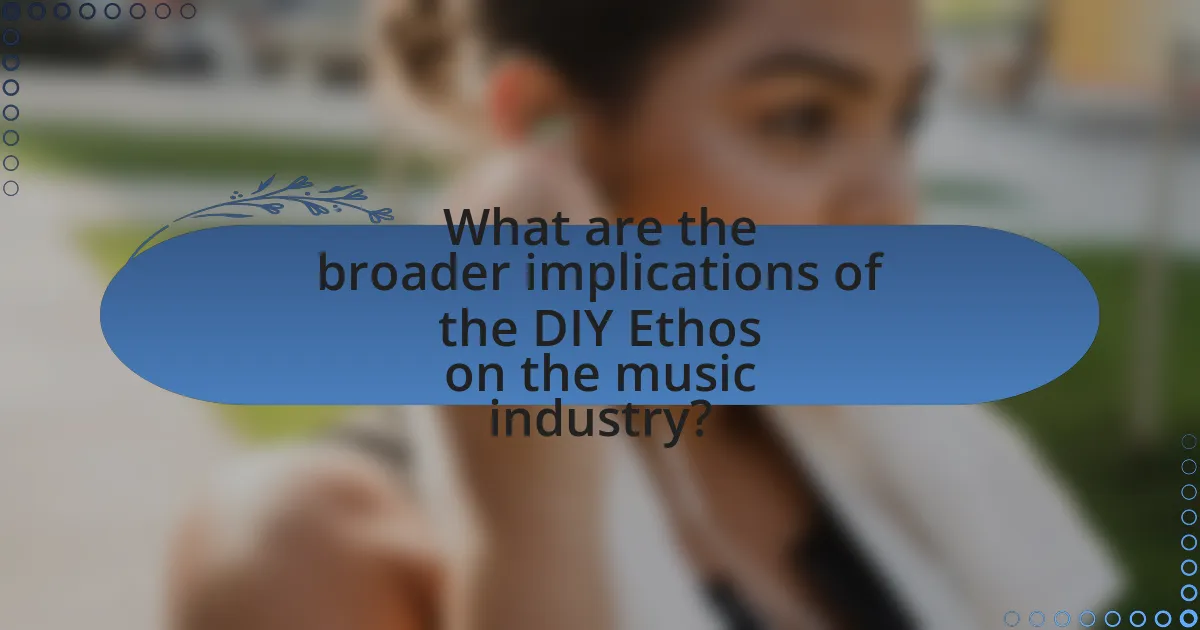The article examines the DIY ethos in music, particularly its influence on experimental rock. It defines the DIY ethos as a philosophy that encourages independent creation, production, and distribution of music, allowing artists to maintain creative control and explore innovative sounds. The emergence of this ethos is traced back to the punk rock movement of the 1970s, highlighting key historical events and technological advancements that facilitated self-production. The article also discusses the core principles of self-sufficiency, creativity, and community engagement, and how these principles have shaped the production techniques and artist-fan relationships within the experimental rock genre. Additionally, it explores the broader implications of the DIY movement on the music industry, including economic impacts and the challenges it poses to traditional industry norms.

What is the DIY Ethos in Music?
The DIY ethos in music refers to a philosophy that encourages artists to create, produce, and distribute their music independently, without reliance on major record labels or commercial entities. This approach fosters artistic freedom, allowing musicians to maintain creative control over their work and often leads to innovative and experimental sounds, particularly in genres like experimental rock. Historically, movements such as punk rock in the 1970s exemplified this ethos, as bands like The Ramones and The Sex Pistols embraced self-production and grassroots distribution methods, which significantly influenced the music landscape.
How did the DIY Ethos emerge in the music scene?
The DIY ethos emerged in the music scene primarily as a response to the commercialization of the music industry during the late 1970s and early 1980s. Musicians and bands sought to create and distribute their music independently, bypassing traditional record labels and commercial constraints. This movement was significantly influenced by punk rock, which emphasized self-production, grassroots promotion, and a rejection of mainstream norms. The rise of affordable recording technology and the accessibility of independent venues further facilitated this shift, allowing artists to take control of their creative output and connect directly with audiences. The ethos was exemplified by bands like The Ramones and The Sex Pistols, who inspired countless others to adopt a similar approach, leading to a flourishing of independent labels and underground scenes.
What historical events influenced the rise of the DIY Ethos?
The rise of the DIY ethos was significantly influenced by the punk rock movement of the 1970s, which emphasized self-production and independence from mainstream music industry practices. This movement arose as a reaction to the commercialization of music, with bands like The Ramones and Sex Pistols advocating for a do-it-yourself approach to music creation and distribution. Additionally, the economic downturn and the rise of home recording technology in the late 20th century further propelled the DIY ethos, allowing artists to produce music without the need for major label support. The availability of affordable recording equipment and the emergence of independent record labels during this period solidified the DIY culture, enabling musicians to take control of their artistic output and reach audiences directly.
How did technology contribute to the DIY movement?
Technology significantly contributed to the DIY movement by providing accessible tools and platforms for individuals to create and distribute their own music. The advent of affordable recording equipment, such as digital audio workstations and home recording software, enabled musicians to produce high-quality recordings without the need for expensive studio time. Additionally, the rise of the internet and social media platforms facilitated the distribution of music, allowing artists to reach global audiences directly, bypassing traditional record labels. This democratization of music production and distribution has been evidenced by the increase in independent artists, with a report from the Recording Industry Association of America indicating that independent labels accounted for 40% of the U.S. music market share in 2020.
What are the core principles of the DIY Ethos?
The core principles of the DIY Ethos include self-sufficiency, creativity, and community engagement. Self-sufficiency emphasizes the importance of individuals taking initiative to create and produce their own work without relying on traditional commercial systems. Creativity encourages experimentation and innovation, allowing artists to explore unconventional methods and ideas. Community engagement fosters collaboration and support among like-minded individuals, promoting a shared sense of purpose and collective growth. These principles have historically empowered musicians and artists, particularly in experimental rock music, to challenge norms and express their unique voices outside mainstream constraints.
How does self-sufficiency play a role in the DIY Ethos?
Self-sufficiency is a fundamental aspect of the DIY ethos, as it empowers individuals to create and produce without reliance on traditional commercial systems. This independence fosters creativity and innovation, allowing artists in experimental rock music to explore unconventional sounds and techniques. Historical examples include bands like Sonic Youth and The Velvet Underground, who embraced self-production and distribution, leading to a significant impact on the genre. Their ability to operate outside mainstream music industry constraints exemplifies how self-sufficiency enhances artistic freedom and experimentation in music.
What impact does community involvement have on the DIY movement?
Community involvement significantly enhances the DIY movement by fostering collaboration, resource sharing, and local engagement. This collective participation leads to the creation of supportive networks that empower individuals to pursue creative projects without reliance on commercial entities. For instance, community workshops and events often provide access to tools and spaces, enabling artists to experiment and innovate. Research indicates that communities with active DIY cultures, such as those in cities like Portland and Berlin, see increased artistic output and diversity, as local artists collaborate and share knowledge. This interconnectedness not only strengthens the DIY ethos but also contributes to the vibrancy of experimental rock music, as musicians draw inspiration from their community’s collective creativity and resources.

How does the DIY Ethos influence Experimental Rock Music?
The DIY ethos significantly influences experimental rock music by encouraging artists to create and distribute their work independently, fostering innovation and diversity in sound. This approach allows musicians to experiment with unconventional techniques and styles without the constraints of commercial expectations. For instance, bands like Sonic Youth and The Velvet Underground exemplified this ethos by self-producing albums and embracing lo-fi aesthetics, which led to groundbreaking sounds that challenged mainstream norms. The rise of home recording technology and independent labels further supported this movement, enabling a broader range of voices and ideas to emerge in the genre.
What characteristics define Experimental Rock Music?
Experimental rock music is characterized by its innovative approach to sound, structure, and instrumentation, often breaking away from traditional rock conventions. This genre frequently incorporates unconventional song forms, diverse musical influences, and the use of non-standard instruments, which can include electronic devices and found sounds. Additionally, experimental rock often emphasizes artistic expression over commercial viability, reflecting a DIY ethos that encourages musicians to explore and push boundaries. Historical examples include bands like The Velvet Underground and Sonic Youth, who utilized avant-garde techniques and embraced a spirit of experimentation, thereby influencing the genre’s evolution.
How do innovation and experimentation manifest in this genre?
Innovation and experimentation in experimental rock music manifest through the incorporation of unconventional sounds, structures, and techniques. Artists in this genre often utilize non-traditional instruments, electronic effects, and innovative recording methods to challenge musical norms. For instance, bands like Sonic Youth and Radiohead have employed alternative tunings and extended song forms, pushing the boundaries of what rock music can be. This approach is rooted in the DIY ethos, which encourages musicians to explore their creativity without the constraints of commercial expectations, leading to a diverse range of sonic landscapes and artistic expressions.
What role does genre-blending play in Experimental Rock?
Genre-blending is fundamental to Experimental Rock as it allows artists to push creative boundaries and explore new sonic landscapes. By incorporating elements from various genres such as jazz, electronic, and classical music, Experimental Rock musicians create innovative soundscapes that challenge traditional rock conventions. This genre-blending fosters a unique artistic expression, exemplified by bands like Radiohead and The Mars Volta, who seamlessly integrate diverse influences into their work. The result is a rich tapestry of sounds that not only expands the genre’s appeal but also reflects the DIY ethos prevalent in Experimental Rock, encouraging artists to experiment freely without the constraints of commercial expectations.
How has the DIY Ethos shaped the production of Experimental Rock Music?
The DIY ethos has significantly shaped the production of experimental rock music by empowering artists to create and distribute their work independently. This approach has led to a diverse range of sounds and styles, as musicians are no longer constrained by traditional industry standards or commercial pressures. For instance, the rise of home recording technology in the late 20th century allowed artists like Sonic Youth and The Velvet Underground to experiment with unconventional techniques and sounds, resulting in groundbreaking albums that challenged the norms of rock music. Additionally, the DIY movement has fostered a collaborative spirit, encouraging musicians to share resources and ideas, which has further enriched the genre. This shift towards self-production and distribution has democratized the music landscape, enabling a wider array of voices and innovations within experimental rock.
What are the common production techniques used by DIY Experimental Rock artists?
DIY Experimental Rock artists commonly utilize techniques such as home recording, unconventional instrumentation, and layering of sounds. Home recording allows artists to produce music in a cost-effective manner, often using basic equipment like digital audio workstations and affordable microphones. Unconventional instrumentation involves the use of non-traditional instruments or found objects, which contributes to the genre’s unique sound. Layering of sounds, including the use of loops and samples, creates complex textures and atmospheres, enhancing the experimental nature of the music. These techniques reflect the DIY ethos, emphasizing creativity and resourcefulness over commercial production methods.
How do independent labels support DIY Experimental Rock musicians?
Independent labels support DIY Experimental Rock musicians by providing essential resources such as funding, distribution, and promotional services. These labels often operate with a focus on artistic integrity, allowing musicians to maintain creative control over their work. For instance, independent labels like Matador Records and Sub Pop have historically championed experimental artists, facilitating their access to recording studios and marketing channels that would otherwise be unavailable. This support enables musicians to reach wider audiences while preserving their unique sound and vision, which is crucial in the experimental rock genre.

What are the broader implications of the DIY Ethos on the music industry?
The DIY ethos has significantly democratized the music industry, allowing artists to produce, distribute, and promote their work independently. This shift has led to a reduction in reliance on traditional record labels, enabling a diverse range of voices and genres to emerge, particularly within experimental rock music. For instance, the rise of platforms like Bandcamp and SoundCloud has facilitated direct artist-to-fan connections, resulting in increased revenue retention for musicians. According to a 2020 report by the Music Industry Research Association, independent artists now account for over 40% of global music revenue, illustrating the profound impact of the DIY movement. This trend not only empowers artists but also fosters innovation and experimentation, as musicians are no longer constrained by commercial pressures from major labels.
How does the DIY Ethos challenge traditional music industry norms?
The DIY ethos challenges traditional music industry norms by promoting self-production and distribution, allowing artists to bypass major labels. This shift empowers musicians to maintain creative control and connect directly with their audience, as seen in the rise of independent labels and platforms like Bandcamp and SoundCloud. Historical examples include the punk movement of the late 1970s, where bands like The Ramones and Sex Pistols recorded and released music without major label support, demonstrating that success can be achieved outside conventional industry structures.
What are the economic impacts of the DIY movement on artists?
The DIY movement has significantly reduced production and distribution costs for artists, enabling them to retain a larger share of their profits. By utilizing home studios and independent distribution channels, artists can create and sell their work without relying on traditional record labels, which often take substantial cuts of revenue. For instance, a study by the Future of Music Coalition found that independent artists who embrace DIY practices can earn up to 70% of their revenue compared to the 10-20% typically received through major labels. This shift empowers artists financially, allowing them to invest more in their creative processes and reach audiences directly, thus fostering a more sustainable economic model within the music industry.
How does the DIY Ethos affect artist-fan relationships?
The DIY ethos fosters a more intimate and collaborative relationship between artists and fans. This approach encourages artists to engage directly with their audience, often through self-produced music, merchandise, and events, which enhances the sense of community. For instance, artists like Sonic Youth and Fugazi have built strong fan bases by prioritizing accessibility and transparency, allowing fans to feel more connected to the creative process. This connection is further evidenced by the rise of crowdfunding platforms, where fans directly support artists, reinforcing their investment in the artist’s work and fostering loyalty.
What lessons can emerging artists learn from the DIY Ethos?
Emerging artists can learn the importance of self-sufficiency and creative control from the DIY ethos. This approach encourages artists to take charge of their own production, distribution, and promotion, allowing them to maintain artistic integrity and connect directly with their audience. Historical examples, such as the punk rock movement of the 1970s, demonstrate how artists like the Sex Pistols and The Ramones utilized DIY methods to create and distribute their music independently, leading to significant cultural impact despite limited resources. By adopting a DIY mindset, emerging artists can cultivate resilience, innovation, and authenticity in their work.
How can artists effectively utilize DIY principles in their careers?
Artists can effectively utilize DIY principles in their careers by taking control of their creative processes, production, and distribution. This approach allows artists to maintain artistic integrity, reduce costs, and engage directly with their audience. For instance, many successful musicians in the experimental rock genre, such as Sonic Youth and The Velvet Underground, have thrived by self-producing their albums and organizing their own tours, which not only fosters a unique sound but also builds a loyal fan base. Additionally, utilizing social media platforms for promotion and crowdfunding for projects exemplifies the DIY ethos, enabling artists to connect with supporters and finance their work without relying on traditional industry gatekeepers.
What resources are available for artists interested in the DIY approach?
Artists interested in the DIY approach can access a variety of resources including online platforms, community workshops, and instructional materials. Online platforms such as Bandcamp and SoundCloud allow artists to distribute their music independently, while websites like YouTube offer tutorials on recording and production techniques. Community workshops often provide hands-on experience and networking opportunities, fostering collaboration among local artists. Additionally, books and online courses on music production, marketing, and self-promotion equip artists with essential skills to navigate the DIY landscape effectively. These resources collectively empower artists to create, distribute, and promote their work without relying on traditional music industry structures.